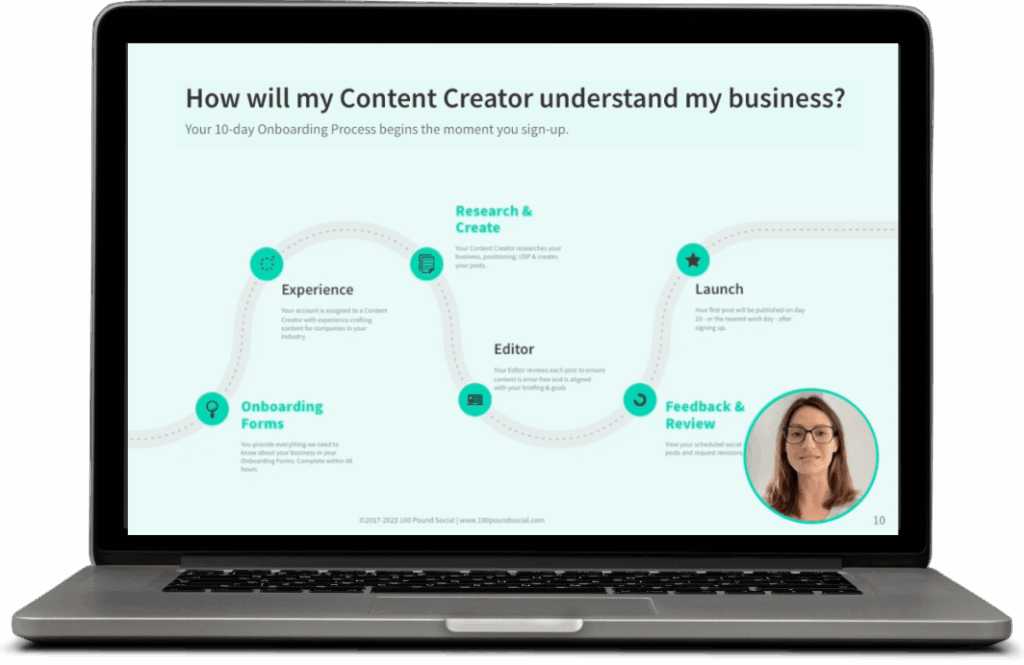Social media is a key part of your wider marketing strategy. Businesses must understand the impact of their social media strategies and how to measure their social media marketing performance.
Tracking your metrics across social media can help you make data-informed, strategic decisions to optimise your marketing and ultimately improve ROI.
But how do you get started? And what are the key metrics in social media marketing? Don’t worry — we’ll explain all but first, let’s look at why social media metrics are important.
What are Social Media Metrics?
Social media metrics are quantifiable data points that measure the performance and impact of your social media marketing activities.
These measurements help track progress, assess campaign effectiveness, and guide strategic decisions about your social media presence.
Think of social media metrics as scoreboards for your online marketing efforts.
Each number tells part of your brand’s story on social platforms – from how many people see your content to how they interact with it and, ultimately, whether these interactions lead to meaningful business results.
These measurements fall into several key categories:
- Awareness metrics show how visible your brand is across social platforms, including measurements like the number of times people see your posts
- Engagement metrics track how users interact with your content through actions like comments and shares
- Conversion metrics measure how effectively your social media efforts drive specific business goals, such as website visits or sales
- Customer service metrics evaluate how well you respond to and support your social media audience
Why Social Media Marketing Metrics Are Important
Social media metrics help to measure the value of your social media marketing efforts. Analysing your social media metrics can help you:
- Understand your audience and take steps to maximise reach and engagement.
- Find out which social media platforms work best for your business.
- Discover when your ideal audience is online and when to schedule posts.
- Create better content by understanding which content drives the best results.
- Monitor and understand your competitors and learn from their successes (and failures!).
- Figure out what strategies work, helping you tweak and optimise your social media marketing plan.
Important Social Media Metrics You Should Be Tracking
What do you want to achieve from your social media marketing?
Once you’ve established the answer to this, it will help you decide your focus areas regarding metrics.
But, there are 13 metrics that every social media marketer should know inside out. Let’s explore these in more detail.
1. Followers
Follower growth is the most visible signal that your business is gaining traction on social media. A follow or like shows someone has taken an interest in your content and business. Follower numbers can be found on your social media profile pages, and tracking numbers and changes is easy.
Follower growth (or any type of social media growth) doesn’t happen overnight and requires time and investment.
Remember also that not all followers are equal — while it may be tempting to try to gain as many followers as humanly possible in those early days, ‘inauthentic’ followers such as bots, mass followers, and empty ‘spam’ accounts can do more harm than good.
2. Likes and Comments
Your audience ‘liking’ a post helps you understand which posts perform best and which topics resonate the most.
Comments are an even better metric. They hold more weight—by commenting, someone is putting more effort into their engagement with your post than simply liking it and then continuing to scroll.
If your posts generate conversations and debates, it’s a clear sign your social media strategy is working.
Monitoring likes, and comments is helpful, but going further and comparing your data to competitors can help highlight improvement opportunities.
3. Response Rate
Response rate refers to how long it takes you to respond to inquiries received via social media channels.
Using AI-powered client service bots will significantly reduce the time it takes to answer simple requests.
You can add your response time directly to your analysis report using an online social client service tool like Hootsuite Inbox.
You can also work out on your response time by adding the time required to respond to client inquiries and dividing by the number of inquiries.
To determine this metric, first, you must set a target for responding to every client’s DMs or tweets within a specified period. If you achieve your goal, the response rate will be 100 percent.
4. Volume and Sentiment
The volume measurement is the number of people discussing your B2B company online. It measures the number of mentions.
Sentiment tells you what clients think about your company. To gauge sentiment, monitor relevant online posts and keywords.
They can be classified by emotion, for example, happiness, sadness or anger.
Analysing these numbers lets you determine how you compare to your competition in online conversations.
You will see the number of people discussing your company online and their opinions compared to your competition’s.
Be sure to track the trends associated with volume and sentiment to find what is most commonly associated with your brand.
5. Shares and Saves
Shares are also a critical engagement metric to monitor. If someone likes or relates to your post so much that they want to share it, they’re highly engaged and promoting you to their wider communities. This type of ‘social proof’ can be instrumental in building your following.
Motivate followers and clients to create user-generated content to promote your business or praise you for excellent service.
6. Clicks
Sometimes, a post performs well but gets zero likes or comments. There are specific posts where users happily click through the link in the post to find out more.
This is why checking your click rates is important.
Tracking clicks is an easy-to-measure metric that can help you identify improvements to your content and give you an idea of any areas you need to work on to improve your social media engagement rate.
7. Reach and Impressions
Many people confuse reach and impressions and even use the terms interchangeably.
Reach tells you how many people your content has reached. Although it’s an older marketing metric, it’s still important for measuring social media success.
Impressions tell you how many times your post was viewed. This might include the same person looking at the post multiple times, but it can give you an idea of the content that resonates best with your ideal audience.
8. Audience Demographics
Understanding your social media audience demographic is critical — this can influence your entire social media marketing strategy.
Knowing your audience’s preferences can help you tweak and adjust your strategy and create engaging content.
The main areas to analyse are:
- Gender
- Age
- Location
- Pain points
- Days and times when most active
- Preferred platforms
Tracking audience metrics also helps determine whether your target audience engages with your content.
9. Referral Traffic
Where do your website leads come from? This is an important metric to measure and is simpler to keep track of than you think.
Again, Google Analytics can help. You can easily measure your website traffic against your website conversions. You can track which sources refer traffic to your website and which traffic sources will most likely convert into leads.
10. Conversions
Conversion rate determines how frequently your social content leads people into an event such as a download, subscription, or sale.
This is among the most crucial statistics of social media marketing since it demonstrates the effectiveness of your online social media efforts (organic or paid) in managing your B2B clients’ funnels.
Calculate the conversion rate with this formula: (total number of social media conversions/ desired metric like clicks, web visits, or impressions) x 100.
If the conversion ratio isn’t high, try A/B testing with different designs, update the content, and experiment with different Calls To Action.
Important Conversion Metrics
How you gauge conversions will be based on what you would like your audience to do, for example:
- Download a resource
- Participate in a webinar
- Visit your website
- Make a purchase
- Join an online demo
- Subscribe to an email newsletter
In terms of conversions, they track the effectiveness of your content in moving prospective clients through the sales funnel. In digital marketing, analysing conversion metrics can help you determine if your marketing strategy is achieving its goals.
Free tools such as Google Analytics and Bitly can track conversions. These tools use cookies to track users’ actions on your site.
11. Cost Per Thousand (CPM)
Cost Per Thousand (CPM) measures how much you pay for 1,000 impressions of your social media content. This metric helps evaluate the cost-effectiveness of your paid social campaigns and compare performance across different platforms.
To calculate CPM:
- Take your total ad spend
- Multiply it by 1,000
- Then divide by the total number of impressions
The formula looks like this:
CPM = (Total Ad Spend × 1,000) ÷ Total Impressions
For example, if you spent £500 on a campaign that received 100,000 impressions:
- CPM = (£500 × 1,000) ÷ 100,000
- CPM = £5
A lower CPM indicates your content reaches more people for less money, while a higher CPM might signal the need to adjust your targeting or creative approach.
12. Net Promoter Score (NPS)
Net Promoter Score (NPS) is a metric used to assess client loyalty and predict how they will feel about your business in the future.
To find out your NPS, you ask clients one question: “How likely are you to recommend our [company/product/service] to a friend?” They answer on a scale from 0 to 10.
Based on their answers, clients fall into three groups:
- Detractors (0-6): Not happy clients.
- Passives (7-8): Neutral clients.
- Promoters (9-10): Very happy clients.
NPS helps you see both current satisfaction and future potential. To calculate NPS, subtract the percentage of detractors from the percentage of promoters. Then, divide by the total number of respondents and multiply by 100.
13. Customer Satisfaction (CSAT) Score
CSAT measures clients’ satisfaction with specific interactions, products, or services.
This metric captures immediate feedback.
The standard CSAT question asks: “How satisfied were you with your experience?”
Response options typically range from 1 (very unsatisfied) to 5 (very satisfied).
To calculate CSAT:
- Count responses of 4 and 5 (satisfied and very satisfied)
- Divide by total responses
- Multiply by 100
Example:
- 200 total responses
- 160 rated 4 or 5
- CSAT = (160 ÷ 200) × 100 = 80%
Benefits of tracking CSAT:
- Identifies specific areas needing improvement
- Helps prevent client churn
- Guides product and service updates
- Shows trends in client satisfaction over time
It’s a good idea to track CSAT alongside other metrics like NPS for a complete picture of client sentiment and loyalty.
14. Social Share of Voice (SSoV)
Social Share of Voice (SSoV) measures how much people talk about your B2B business on social media compared to your competitors.
Mentions can be:
- Direct (tagged, like “@100 Pound Social”)
- Indirect (untagged, like just saying “100 Pound Social”)
SSoV shows how visible and relevant your brand is in your industry. To calculate it:
- Count every mention of your brand on social media.
- Do the same for your competitors.
- Add all these mentions together to get a total for your industry.
- Divide your brand’s mentions by this total, then multiply by 100 to get your SSoV as a percentage.
15. Amplification Rate
Amplification Rate is how often your followers share your posts with others.
It shows how much your followers help spread your content.
A higher amplification rate means your followers share your posts more, increasing your reach. To calculate it, divide the total number of shares for a post by your total number of followers. Multiply by 100 to get the amplification rate as a percentage.
Where to Find Engagement Metrics
Checking engagement metrics on your social media platforms is straightforward. We will concentrate on the ‘Big Four’ B2B marketing-friendly social media platforms — LinkedIn, Facebook, X (Twitter), and Instagram.
| Platform | How To Access Insights | Useful Info |
| LinkedIn Company Page | Sign in to your page’s admin centre. Click the Analytics tab in the menu. Select Updates, Followers, or Visitors from the dropdown menu. | Page analytics are only visible to admins or people with “analyst” access. You can view metrics for a specific post by clicking Show Stats in the bottom right corner of a post. You can also track profile analytics. |
| LinkedIn Personal Profile | Log in to your LinkedIn profile. Click on your profile picture OR your name to enter your personal profile. Scroll down to the section labelled Analytics, and click on Show All Analytics. | The dashboard is only visible to you, you can see detailed analytics including your post impressions, followers, profile viewers, and search appearances. |
| Click the Insights tab in the menu bar across the top of your Facebook Page. | You can only access data in Page Insights for the last two years, and demographic data is only available once there’s data for over 100 people. | |
| X (Twitter) | Log in to your X (Twitter) account and head to the Tweet Activity Dashboard. | You can see how people engage with your Tweet in ’real-time’ and compare activity and followers between Tweets.You can also click on any Tweet for a more detailed metrics breakdown. |
| You can only access insights on the mobile app. Click on the menu icon in the upper-right corner, then choose Insights. | You need a Business profile to access insights — if you’re currently using a personal one, you’ll need to convert. |
Tools for Tracking Social Media Engagement
Here are some tools in detail for tracking social media engagement:
HeyOrca
Platforms: Facebook, X (Twitter), Linkedin, Pinterest, Instagram, Canva, Threads, Tiktok, ChatGPT.
Free Insights/Features: Client-specific calendars, AI-powered captions, data-driven insights, and easy client approvals.
Pricing: Basic £46.66, per calendar/month. Free or available as an add-on for 100 Pound Social clients.
Here at 100 Pound Social we use HeyOcra to manage our client’s social media posts. It is a platform that helps teams and organisations manage social media more effectively. It facilitates the easy creation, planning, and approval of content.
It means our clients can track their social media metrics and post performance, as well as being able to review content directly and easily to see what’s coming up.
Hootsuite
Platforms: Facebook, Instagram, YouTube, LinkedIn, X (Twitter)
Free Insights/Features: Overview of key metrics, Unlimited real-time reports, Team performance measurement
Pricing: 30-day free trial, plans from £39/mo
Hootsuite gives you a comprehensive view of your social media accounts, so you don’t have to examine each platform separately.
It makes it simple to analyse payoffs across different social media networks. With Hootsuite’s social benchmarking feature, you can see how your industry peers perform on social media and evaluate your payoff within a few clicks.
Zoho Social
Platforms: Facebook, Instagram, LinkedIn, X (Twitter)
Free Insights/Features: Statistics for individual posts, Analytics for content type, best time to post, and more
Pricing: 15-day free trial, plans from £8/mo
The platform’s free social media monitoring capabilities are beneficial when Zoho is used as a CRM.
In addition to the usual monitoring tools we’ve discussed, the platform allows you to create a custom listening dashboard. This dashboard will include everything from hashtags to platform outlets and give you an overview of your social and PR presence in a single glance.
Sendible
Platforms: Facebook, X (Twitter), Instagram, LinkedIn
Free Insights/Features: Report builder, Reports for each social media channel
Pricing: 30-day free trial, plans from £21/mo
Sendible is a powerful Social Media Management tool that allows users to track analytics, produce reports, and design and schedule content on diverse social media platforms without leaving the platform.
Through Sendible, you can track industry-specific keywords and brand mentions and respond to feedback on several platforms.
Iconosquare
Platforms: Facebook, Instagram, LinkedIn, X (Twitter)
Free Insights/Features: Advanced analytics, Competitor and hashtag tracking, Industry benchmarks, Facebook account audits, Instagram account audits
Pricing: 14-day free trial, plans from £49/mo
Iconosquare lets you track brand metrics across many social profiles. It also lets you compare time intervals and monitor more than 100 metrics in diagrams or raw data.
You can compare your performance against your competition and schedule your reports to be delivered to your inbox regularly.
Keyhole
Keyhole allows you to report on social media campaign results, including brand interactions, mentions, and hashtags’ impact.
You can analyse your impressions, reach, and shares and examine your competitors’ media strategies.
Google Analytics
The most exciting feature is to check how many leads and traffic are flowing to your site through your social channels.
Google Analytics is a valuable free tool for learning about your website’s visitors. If you’re a B2B business owner looking to increase your site’s visitors and leads, its use is necessary.
Although it’s not a stand-alone analysis tool for social media, it can be used to build reports that benefit you:
- Check out which social media sites bring you the most traffic.
- Check out which content generates the most leads and traffic on what social media platforms.
- Learn about your target audience by analysing demographics.
- Determine the return on investment from your social media marketing campaigns.
These information points will allow you to make the most of your online social media marketing and effectively plan for the near future.
A social media strategy is not comprehensive without Google Analytics.
Sprout Social
Relying on different platforms’ analytics dashboard results means a lot of work.
Sprout offers all the most important statistics and performance data from a single location and streamlines your workflow.
You can create quick and easy reports for your social media accounts using the Sprout analytical and reporting features. For instance, the report on post-performance swiftly determines your most popular posts across different networks.
It lets you quickly modify your strategy and provide your users with the necessary information.
Additionally, you can send customised reports designed specifically for your audience. The reports will focus on certain channels, overall performance, and competitors.
The perfect aspect is that Sprout simplifies tracking how the shortened links are doing.
Start your free Sprout trial today.
BuzzSumo
While it is not strictly a tool for social interaction, BuzzSumo is a fantastic resource for studying the level of engagement on social media for any particular content.
If you’d like to know the number of shares your latest blog post has received via Facebook, X (Twitter), or Pinterest, BuzzSumo will provide you with this information.
It also allows you to monitor your performance on content competing with relevant keywords within the industry. It lets you know how your content marketing campaigns stack up against your competition.
Social media is a goldmine for content distribution. By delving into the shares on social media, you can pinpoint the posts that resonate the most with your audience.
Armed with this knowledge, you can strategically shape your content strategy.
BuzzSumo is your ally in identifying the key factors contributing to successful content, such as duration, date of publication, and headline format, making you feel informed.
Talkwalker
Talkwalker brings together social media monitoring and analytics in one comprehensive platform.
What sets this tool apart is its combination of market research capabilities with social listening features that analyses both text and visual content across social networks, blogs, forums, and news sites.
The platform tracks real-time mentions across multiple channels, giving you a complete view of your online presence.
Using Talkwalker provides strong competitive advantages through its market analysis features. The platform tracks competitor activities and industry trends, providing context for your own social media performance.
Meta Business Suite
Meta Business Suite simplifies social media management by bringing Facebook and Instagram operations into one streamlined dashboard.
This integration saves considerable time when managing your presence across Meta’s platforms, eliminating the need to switch between different apps or interfaces.
At its core, the platform offers smart content management features.
You can create, schedule, and publish posts for both Facebook and Instagram simultaneously. The scheduling tool helps maintain consistent posting schedules.
The tool also allows you to plan content when your audience is most active.
How to Improve Your Strategy with Social Media Metrics
Social media metrics mean little without strategic application.
Here’s how to turn your data into actionable improvements for your social media strategy:
- Start by establishing your baseline numbers. Record your performance across key metrics like engagement rates, follower growth, and conversion numbers.
- Match each metric to specific business goals. For example, if sales growth tops your priority list, focus on conversion rates and click-through statistics. Pay attention to reach, impressions, and engagement metrics for brand building.
- Create a regular review schedule. Set aside time weekly to check short-term trends and monthly for deeper analysis. This consistent monitoring helps spot patterns early.
- Watch your audience’s behaviour patterns. Notice which content types generate the most shares and saves – these signal what your audience finds valuable enough to keep or pass along. Use this information to guide your content creation.
Next Steps
If lack of time prevents you from building a social media strategy, 100 Pound Social can help by offering expert social media management and SEO-optimised Blog Article and Newsletter packages.
Niche business? We’re up to the challenge. Since 2017, we’ve served over 1,000 businesses worldwide across a huge range of industries, sectors, and specialities.
Book a call today, or hop on to a free, interactive 15-minute demo!
| POSTS PLAN |
| from £100 (+VAT) per month |
| Dedicated UK-based Content Creator & Editor |
| Regular handcrafted posts each week |
| Dedicated Client Success Manager |
| Add extra posts and platforms |
| Get started now |







